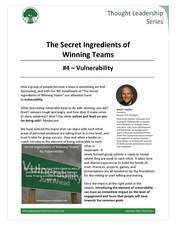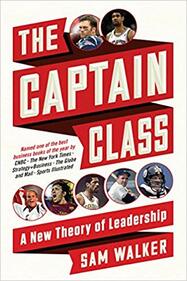|
Secret Ingredients of Winning Teams Six years ago Sara and I started Banyan Tree Strategies to help people build re-mark-able businesses and we are thankful for its success. In the midst of our work we started to notice a correlation between what we were doing for companies and our past experiences as professional athletes and more recently as youth sports coaches. What was our big revelation? Everyone wants to be on a winning team and nobody wants to be tagged as not being a team player. OK. We get it, big deal, everyone knows that already. Then why is it so hard to repeat as a winner, and why do most teams fail? We took what we are learning from CEO’s and are applying it ranging from college coaches, to people coming out of college looking to grow their networks, to 6th grade lacrosse coaches. Four times a year we will share our insights called “The Secret Ingredients of Winning Teams,” a topic we have touched on at various moments in our Banyan Tree Branches & Roots Newsletter. We hope our research can help you in your efforts to build winning teams in all facets of your life. These are the themes we are currently following: • The coach’s pursuit of collective excellence • How small societies impact performance • The evolving role of the captain  Collective Excellence There are many noble pursuits for a coach at the beginning of the season and we hardly ever bump into one who is volunteering their time in the hopes of causing a kid to quit the sport. However, if we were to vote on one of the hardest goals to obtain, we would put achieving collective excellence above going undefeated and winning the all-city title. Our definition of collective excellence has its roots in the work of John Wooden and those who also seek to build a personal relationship with each player in the joint pursuit of the team’s goals. The ability of the coach to build trust with the player, to such an extent that the player can agree to the role the coach has constructed for that season is crucial. It's part sales pitch and part plea for support and trust. Each season is as an opportunity for the coach to have a scouting report done on themselves, a book as it were. It answers the question, how do we beat this coach? Scouting reports are common on players: what is the book on that guy?
A coach should also want to know what “the book” is on them at this point in their career, and then work the next season to improve. So what is the book on you right now? The coach who trusts his or her team enough to be vulnerable with them should be well on their way to existing in a state of consensual interdependence with the rest of the coaching staff and the players. We wrote about this in one of our Thought Leadership Series pieces shown here. The pursuit of collective excellence begins with the coaching staff and then continues through to the players. If you can think of a team you were on that achieved this, please share with us as we continue to build out stories on this topic.  How Small Societies Impact Performance We first heard this term small societies from UNC women's soccer coach Anson Dorrance in a talk he gave at the What Drives Winning Conference in 2015. It was a scant reference at the beginning of the talk (minute 1:15), but for geeks like us, it was cause for research. Dorrance is a coach in pursuit of collective excellence. He is building a cumulative chest of wisdom on the topic of human collaboration in the pursuit of putting a ball in a net and caring about each other in the process. His research led him to discover Cesar Luis Menotti of Argentina who had the high pressure job of being that country's national soccer team coach. It was Menotti who started talking about the teams within the teams, calling them small societies when describing the relationships between the goalie and the fullbacks, the right midfielder with the center forward. It is similar to Metcalf’s law of networks and how intertwined our relationships can get.  Our current learning is this: Consider looking at your team the same way you would look at this square. You know you are going to be asked, how many squares can you see? If a square is a small society that could exist on your team, how many can you see? Make a list of small societies for your team and then if you feel like it, share it with us. As the coach, you can’t advise and mentor what you can’t observe. We have reached out to Dorrance with no success to date. If you have a link to him, please let us know as we would love 15 minutes to have a conversation on his current thoughts.  Oh Captain, My Captain No topic has captured our attention in the area of teams more in the past six months than the role of the Captain. Both Sara and I were captains of our high school and college teams. Both of us found it an arduous role to fill. In the decades since we have spoken to countless others who had similar experiences and were delighted to find that Sam Walker did years of research and published “The Captain Class.” His goal was to answer one of the most challenging questions in the history of sport: who are the best teams of all time? In all sports, in all time? Talk about a Mt. Everest goal. He also had a second goal. If he could make a claim that there was one class above the rest, did they have any characteristics in common? Turns out he could and there was. It was that they had a certain type of Team Captain. He then went on to identify that those captains had seven characteristics in common. This was pure catnip for us and led us to interview as many college, high school, and youth sport coaches we could and ask, if this is true, then how can you incorporate identifying potential captains and then developing them as part of your program? What we heard and how coaches are changing what they are doing in response to the data is encouraging.
We will continue to review this effort in this section of the publication. Here is a copy of what we send to coaches prior to our conversations with them, feel free to send it to any coach you know and we would love their advice and comments. Thank you so much for your readership and engagement with our research on building and maintaining winning teams. Winning together is a jump for joy moment and we think those are worth the blood, sweat, and toil that goes into being collectively excellent. We will be back to you in the middle of May with our latest insights that we glean from our network of awesome contributing coaches and leaders.
0 Comments
|
Archives
November 2023
Categories
All
Complete Annual Newsletter Volumes
|

